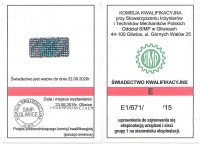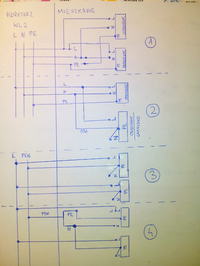Dear forum members,
I am addressing you as definitely more experienced colleagues and I am asking for your understanding as my questions may seem trivial but I do not know the answers to them. Well, I would like to know your opinion (preferably supported by legal regulations) what the permissions I have really allow me to do? -
Qualification Certificate E - authorization to operate equipment and networks of group 1 at the operating position in the field of operation, maintenance, repairs, assembly for the following installation and network devices: Group I Electric power equipment, installations and networks generating, transmitting and consuming electricity: 2 ) devices, installations and power networks with a voltage of no more than 1 kV (detailed scan attached in the appendix)
Completed electrical technical school - if it has any importance.
I don't run a business - if it matters.
To be more precise, I will ask about specific cases:
1. Connection of a 230 V / 400 V induction cooker - I go to someone, there is an old induction cooker on site, quite old 7 x 2.5 mm2 cable (copper) without color-coded wires, after inspection I find 3 phases and a neutral wire (in in this case called rather PEN?), I do not find the protective conductor (PE). There is no residual current device in the installation.
a) whether my powers and regulations allow me to install the panel in such a specific situation by connecting the phase conductors, making the PEN conductor to N and PE at the panel connection point (or creating a bridge) and connecting the N conductor coming from the panel to it and PE conductor?
b) or maybe I should search the fuse table for one of these free wires from this cable and connect it to the PE bus (if there is) and if it is not there to the (PEN) bus, create a protective conductor - is it perhaps too many for this these permissions because it is a change in the existing installation?
c) after such a connection, someone with higher powers than mine should take some measurements and prepare a protocol, stamp the warranty card with his stamp.
d) or maybe I can not connect the induction hob with such rights? - on the forum here, I read that people were saying that the producers of the boards require that after connecting the board, measurements should be made and a protocol attached, which, as you know, I cannot do, and even wrote that the connection must be made by a person who runs a business in the sense that the permissions alone are not enough.
Question 1) What is your opinion on this particular case?
Question 2) What do these powers allow me to do in practice?
The post may have become multi-threaded because it concerns both the technical thread and what my permissions allow, but I count on your understanding and your help.
I am addressing you as definitely more experienced colleagues and I am asking for your understanding as my questions may seem trivial but I do not know the answers to them. Well, I would like to know your opinion (preferably supported by legal regulations) what the permissions I have really allow me to do? -
Qualification Certificate E - authorization to operate equipment and networks of group 1 at the operating position in the field of operation, maintenance, repairs, assembly for the following installation and network devices: Group I Electric power equipment, installations and networks generating, transmitting and consuming electricity: 2 ) devices, installations and power networks with a voltage of no more than 1 kV (detailed scan attached in the appendix)
Completed electrical technical school - if it has any importance.
I don't run a business - if it matters.
To be more precise, I will ask about specific cases:
1. Connection of a 230 V / 400 V induction cooker - I go to someone, there is an old induction cooker on site, quite old 7 x 2.5 mm2 cable (copper) without color-coded wires, after inspection I find 3 phases and a neutral wire (in in this case called rather PEN?), I do not find the protective conductor (PE). There is no residual current device in the installation.
a) whether my powers and regulations allow me to install the panel in such a specific situation by connecting the phase conductors, making the PEN conductor to N and PE at the panel connection point (or creating a bridge) and connecting the N conductor coming from the panel to it and PE conductor?
b) or maybe I should search the fuse table for one of these free wires from this cable and connect it to the PE bus (if there is) and if it is not there to the (PEN) bus, create a protective conductor - is it perhaps too many for this these permissions because it is a change in the existing installation?
c) after such a connection, someone with higher powers than mine should take some measurements and prepare a protocol, stamp the warranty card with his stamp.
d) or maybe I can not connect the induction hob with such rights? - on the forum here, I read that people were saying that the producers of the boards require that after connecting the board, measurements should be made and a protocol attached, which, as you know, I cannot do, and even wrote that the connection must be made by a person who runs a business in the sense that the permissions alone are not enough.
Question 1) What is your opinion on this particular case?
Question 2) What do these powers allow me to do in practice?
The post may have become multi-threaded because it concerns both the technical thread and what my permissions allow, but I count on your understanding and your help.





